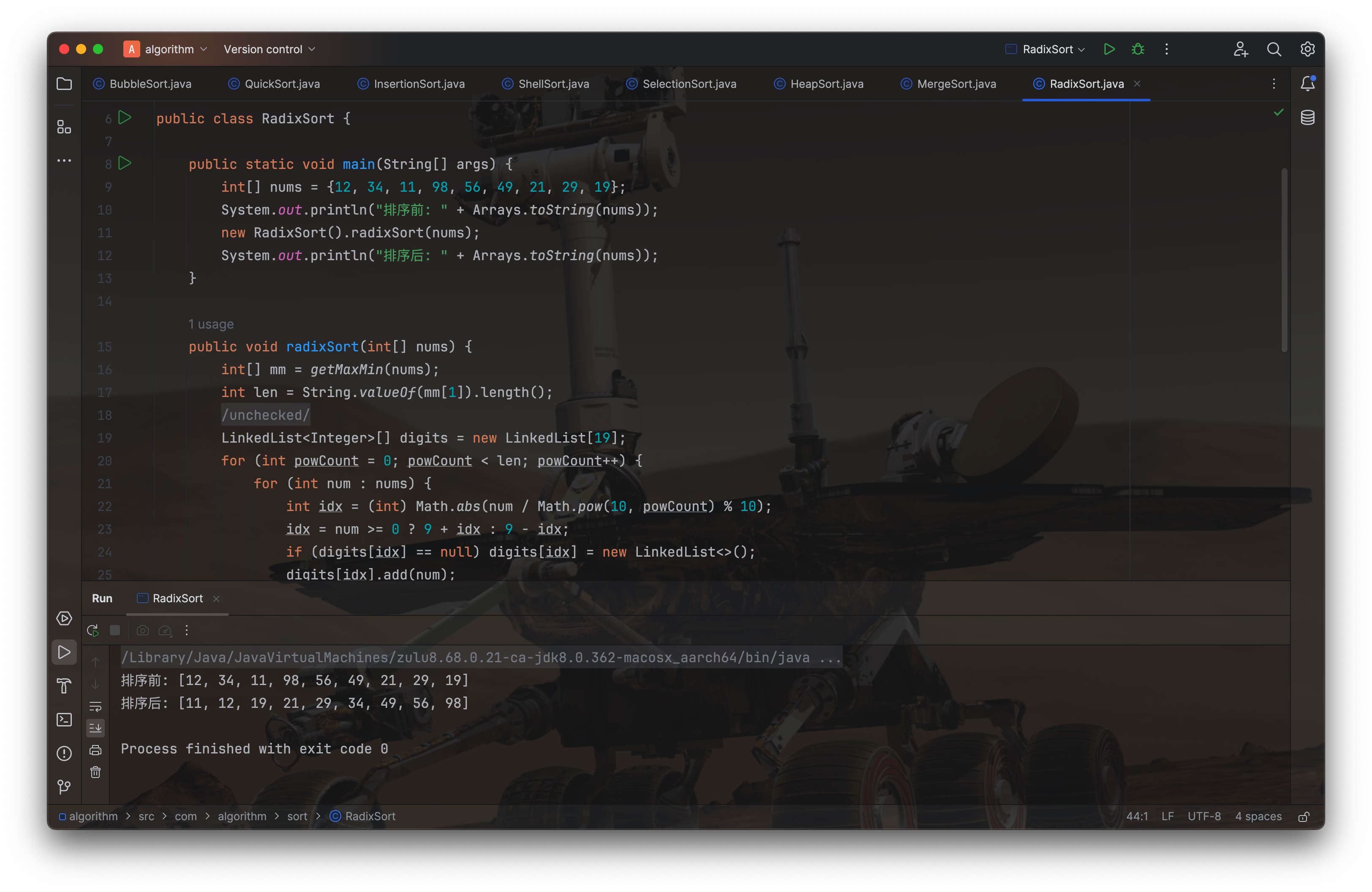Java排序算法-持续更新中
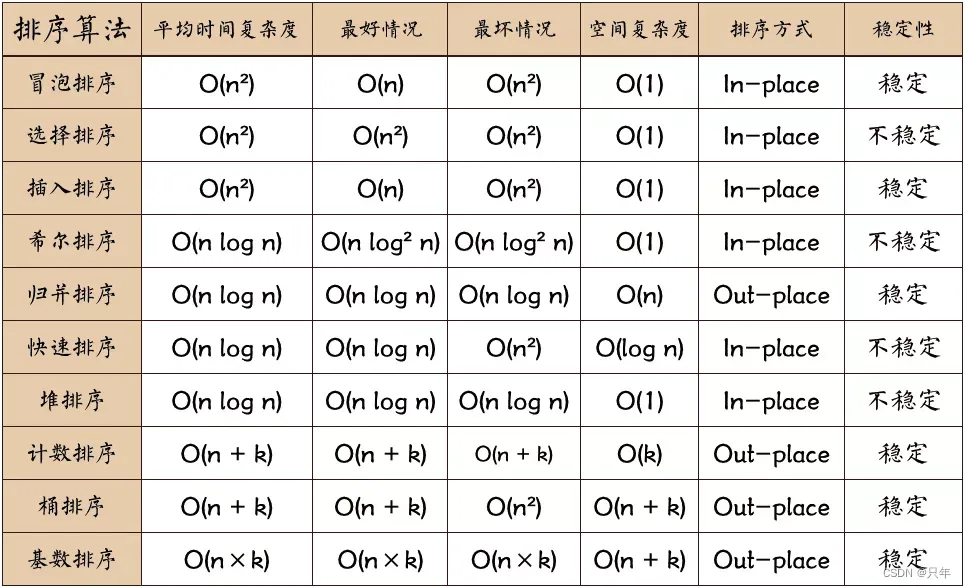
一、比较排序
1.1 交换排序
数组两元素交换位置
public class ArrayUtil {/*** 交换数组中的两个元素* @param array 数组* @param ele1Idx 元素1的索引下标* @param ele2Idx 元素1的索引下表*/public static void swap(int[] array, int ele1Idx, int ele2Idx) {int tmp = array[ele1Idx];array[ele1Idx] = array[ele2Idx];array[ele2Idx] = tmp;}
}
1.1.1 冒泡排序
public class BubbleSort {public static void main(String[] args) {int[] nums = {12, 34, 11, 98, 56, 49, 21, 29, 19};System.out.println("排序前: " + Arrays.toString(nums));new BubbleSort().bubbleSort(nums);System.out.println("排序后: " + Arrays.toString(nums));}private void bubbleSort(int[] nums) {for (int i = 0; i < nums.length - 1; i++) {for (int j = 0; j < nums.length - 1 - i; j++) {if (nums[j] > nums[j + 1]) {ArrayUtil.swap(nums, j, j + 1);}}}}
}

1.1.2 快速排序
public class QuickSort {public static void main(String[] args) {int[] nums = {12, 34, 11, 98, 56, 49, 21, 29, 19};System.out.println("排序前: " + Arrays.toString(nums));new QuickSort().quickSort(nums, 0, nums.length - 1);System.out.println("排序后: " + Arrays.toString(nums));}private void quickSort(int[] nums, int start, int end) {if (start > end) return;int i = start, j = end, base = nums[start];while (i < j) {while (j >= 0 && nums[j] >= base) j--;while (i < j && nums[i] <= base) i++;if (i < j) {ArrayUtil.swap(nums, i, j);}}ArrayUtil.swap(nums, start, i);quickSort(nums, start, i - 1);quickSort(nums, i + 1, end);}
}
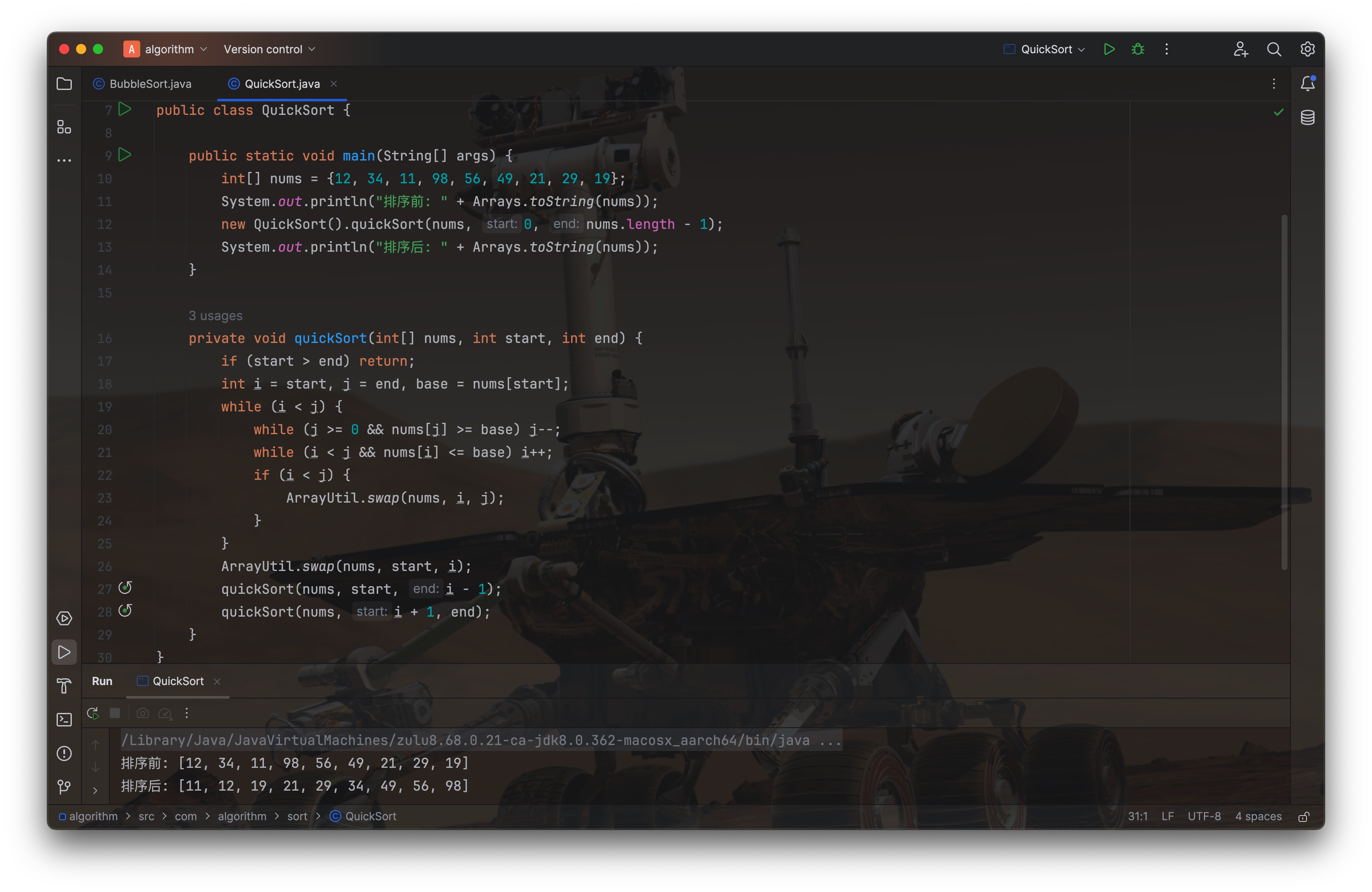
1.2 插入排序
1.2.1 简单插入排序
public class InsertionSort {public static void main(String[] args) {int[] nums = {12, 34, 11, 98, 56, 49, 21, 29, 19};System.out.println("排序前: " + Arrays.toString(nums));new InsertionSort().insertionSort(nums);System.out.println("排序后: " + Arrays.toString(nums));}private void insertionSort(int[] nums) {for (int i = 1; i < nums.length; i++) {int j, temp = nums[i];for (j = i; j > 0 && nums[j - 1] > temp; j--) {nums[j] = nums[j - 1];}nums[j] = temp;}}
}

1.2.2 希尔排序
public class ShellSort {public static void main(String[] args) {int[] nums = {12, 34, 11, 98, 56, 49, 21, 29, 19};System.out.println("排序前: " + Arrays.toString(nums));new ShellSort().shellSort(nums);System.out.println("排序后: " + Arrays.toString(nums));}private void shellSort(int[] nums) {// 缩小增量排序for (int gap = nums.length / 2; gap >= 1; gap /= 2) {for (int i = gap; i < nums.length; i++) {int j, temp = nums[i];for (j = i; j >= gap && nums[j - gap] > temp; j-=gap) {nums[j] = nums[j - gap];}nums[j] = temp;}}}
}
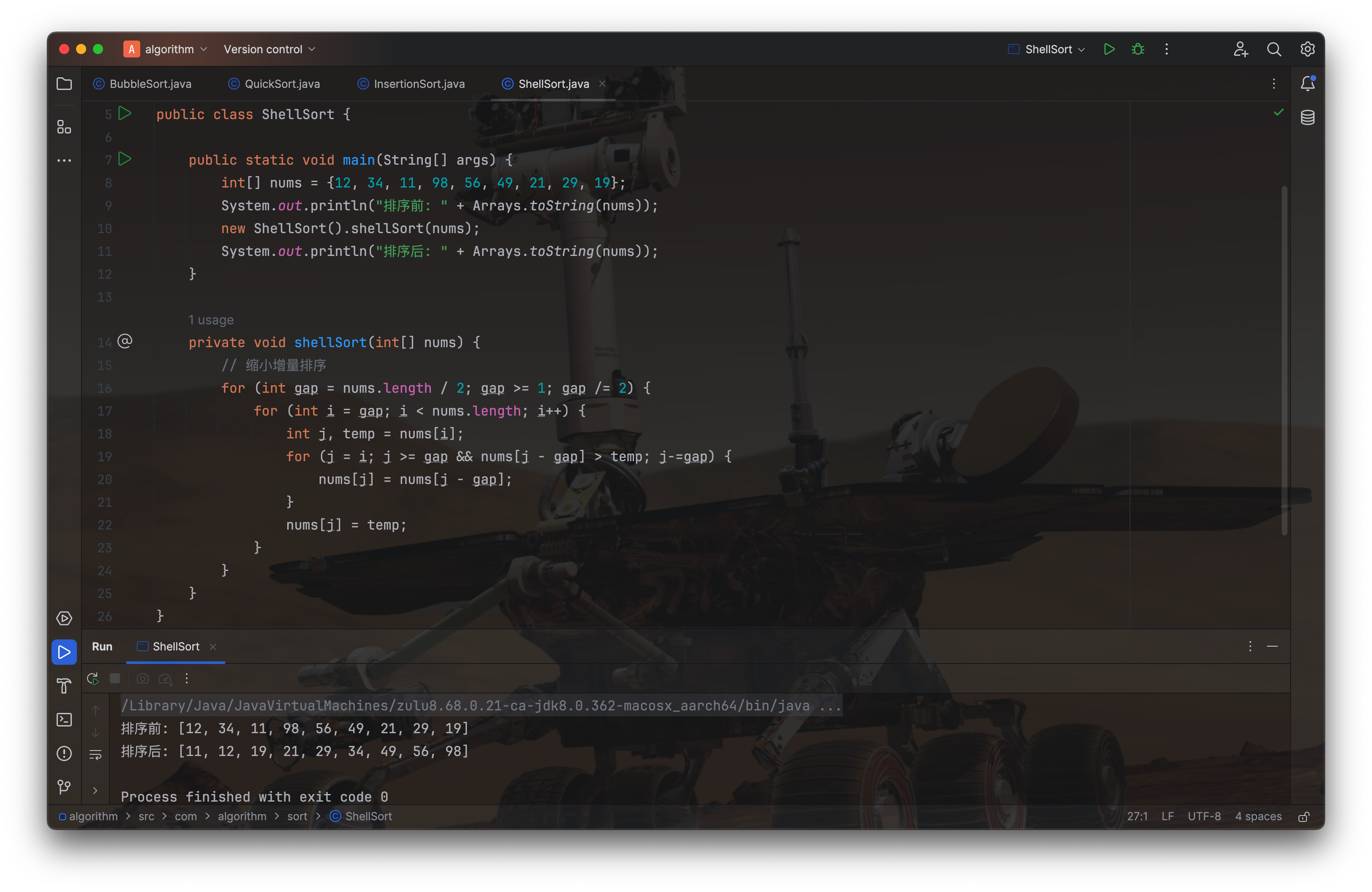
1.3 选择排序
1.3.1 简单选择排序
public class SelectionSort {public static void main(String[] args) {int[] nums = {12, 34, 11, 98, 56, 49, 21, 29, 19};System.out.println("排序前: " + Arrays.toString(nums));new SelectionSort().selectionSort(nums);System.out.println("排序后: " + Arrays.toString(nums));}private void selectionSort(int[] nums) {for (int i = 0; i < nums.length - 1; i++) {for (int j = i + 1; j < nums.length; j++) {if (nums[i] > nums[j]) {ArrayUtil.swap(nums, i, j);}}}}
}
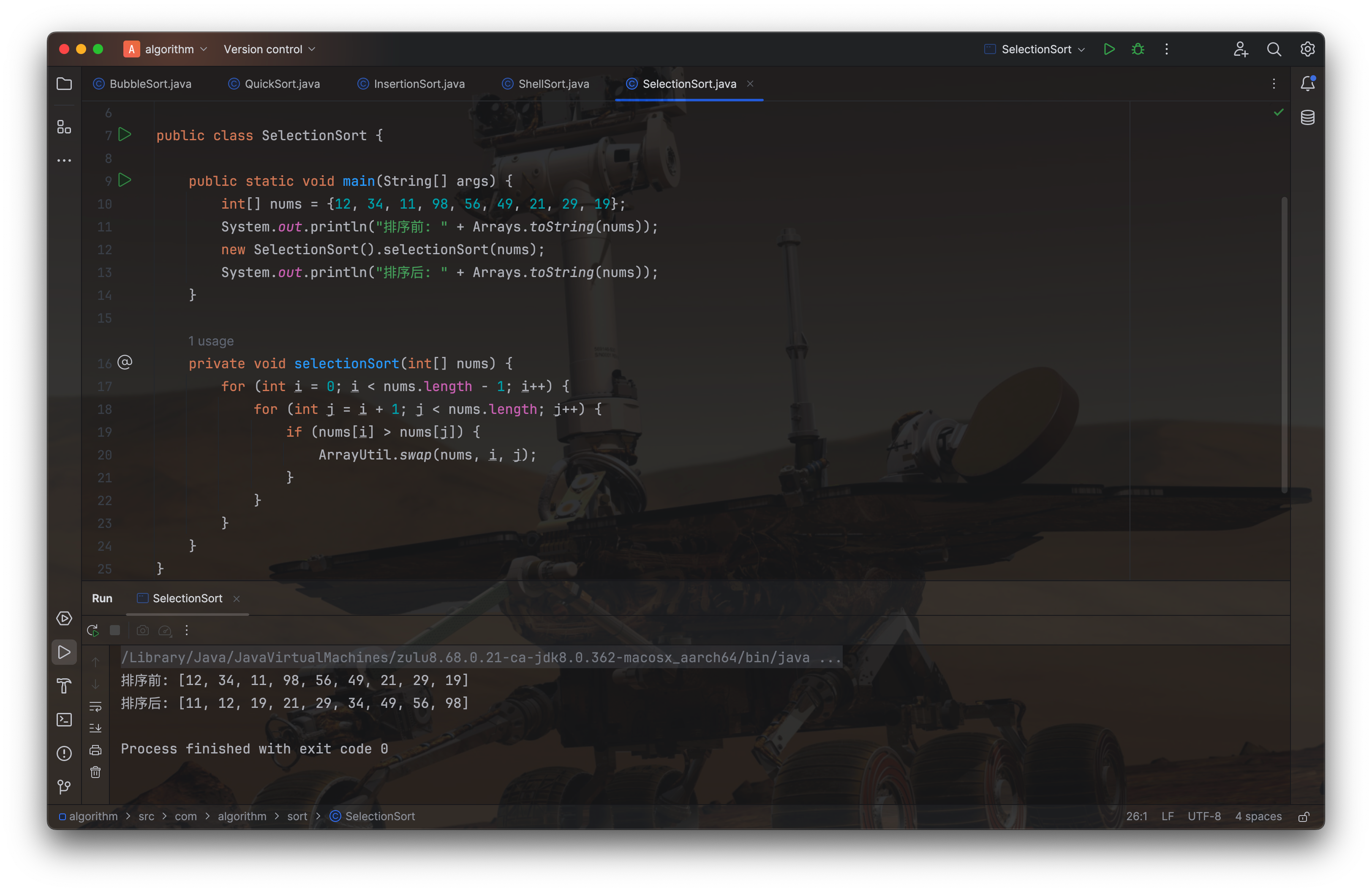
1.3.2 堆排序
public class HeapSort {public static void main(String[] args) {int[] nums = {12, 34, 11, 98, 56, 49, 21, 29, 19};System.out.println("排序前: " + Arrays.toString(nums));new HeapSort().headSort(nums);System.out.println("排序后: " + Arrays.toString(nums));}private void headSort(int[] nums) {int n = nums.length;buildHeap(nums, n);for (int i = n - 1; i >= 0 ; i--) {swap(nums, i, 0);heapify(nums, i, 0);}}private void buildHeap(int[] tree, int n) {int lastNodeIndex = n - 1;int parentNodeIndex = (lastNodeIndex - 1) / 2;for (int i = parentNodeIndex; i >= 0; i--) {heapify(tree, n, i);}}private void heapify(int[] tree, int n, int i) {if (i > n) {return;}int l = 2 * i + 1;int r = 2 * i + 2;int max = i;if (l < n && tree[l] > tree[max]) {max = l;}if (r < n && tree[r] > tree[max]) {max = r;}if (max != i) {swap(tree, max, i);heapify(tree, n, max);}}private void swap(int[] nums, int left, int right) {int temp = nums[left];nums[left] = nums[right];nums[right] = temp;}
}

1.4 归并排序
1.4.1 二路归并排序
public class MergeSort {public static void main(String[] args) {int[] nums = {6, 8, 10, 9, 4, 5, 2, 7};new MergeSort().mergeSort(nums, 0, nums.length - 1);System.out.println(Arrays.toString(nums));}private void mergeSort(int[] arr, int l, int r) {if (l == r) return;int m = (l + r) / 2;mergeSort(arr, l, m);mergeSort(arr, m + 1, r);merge(arr, l, m + 1, r);}private void merge(int[] arr, int l, int m, int r) {int lSize = m - l;int rSize = r - m + 1;int[] lArr = new int[lSize];int[] rArr = new int[rSize];// 1.fill in the left sub arrayif (m - l >= 0) System.arraycopy(arr, l, lArr, 0, lSize);// 2.fill in the right sub arrayif (r + 1 - m >= 0) System.arraycopy(arr, m, rArr, 0, rSize);// 3.merge into the original arrayint i = 0, j = 0, k = l;while (i < lSize && j < rSize) {if (lArr[i] < rArr[j]) {arr[k++] = lArr[i++];} else {arr[k++] = rArr[j++];}}while (i < lSize) {arr[k++] = lArr[i++];}while (j < rSize) {arr[k++] = rArr[j++];}}
}

1.4.2 多路归并排序
待更新...
二、非比较排序
2.1 计数排序
public class CountingSort {public static void main(String[] args) {int[] nums = {12, 34, 11, 98, 56, 49, 21, 29, 19};System.out.println("排序前: " + Arrays.toString(nums));new CountingSort().countingSort(nums);System.out.println("排序后: " + Arrays.toString(nums));}public void countingSort(int[] nums) {int[] mm = getMaxMin(nums);int[] cnt = new int[mm[1] - mm[0] + 1];for (int num : nums) {cnt[num - mm[0]] += 1;}int idx = 0;for (int i = 0; i < cnt.length; i++) {for (int j = 0; j < cnt[i]; j++) {nums[idx++] = i + mm[0];}}}private static int[] getMaxMin(int[] nums) {int max = nums[0], min = nums[0];for (int i = 1; i < nums.length; i++) {if (nums[i] > max) max = nums[i];if (nums[i] < min) min = nums[i];}return new int[]{min, max};}
}

2.2 桶排序
public class BucketSort {public static void main(String[] args) {int[] nums = {12, 34, 11, 98, 56, 49, 21, 29, 19};System.out.println("排序前: " + Arrays.toString(nums));new BucketSort().bucketSort(nums);System.out.println("排序后: " + Arrays.toString(nums));}public void bucketSort(int[] nums) {if (nums == null || nums.length == 0) {return;}// 找出数组中的最大值和最小值int[] mm = getMaxMin(nums);// 初始化桶数组int listSize = mm[1] - mm[0] + 1;List<List<Integer>> buckets = new ArrayList<>(listSize);for (int i = 0; i < listSize; i++) {buckets.add(new ArrayList<>());}// 将数据分配到桶中for (int num : nums) {buckets.get(num - mm[0]).add(num);}// 对每个桶进行排序,这里使用了简单的Insertion Sortfor (List<Integer> numList : buckets) {if (!numList.isEmpty()) {Collections.sort(numList);}}// 从桶中收集已排序的数据int k = 0;for (List<Integer> bucket : buckets) {for (Integer value : bucket) {nums[k++] = value;}}}private static int[] getMaxMin(int[] nums) {int max = nums[0], min = nums[0];for (int i = 1; i < nums.length; i++) {if (nums[i] > max) max = nums[i];if (nums[i] < min) min = nums[i];}return new int[]{min, max};}
}
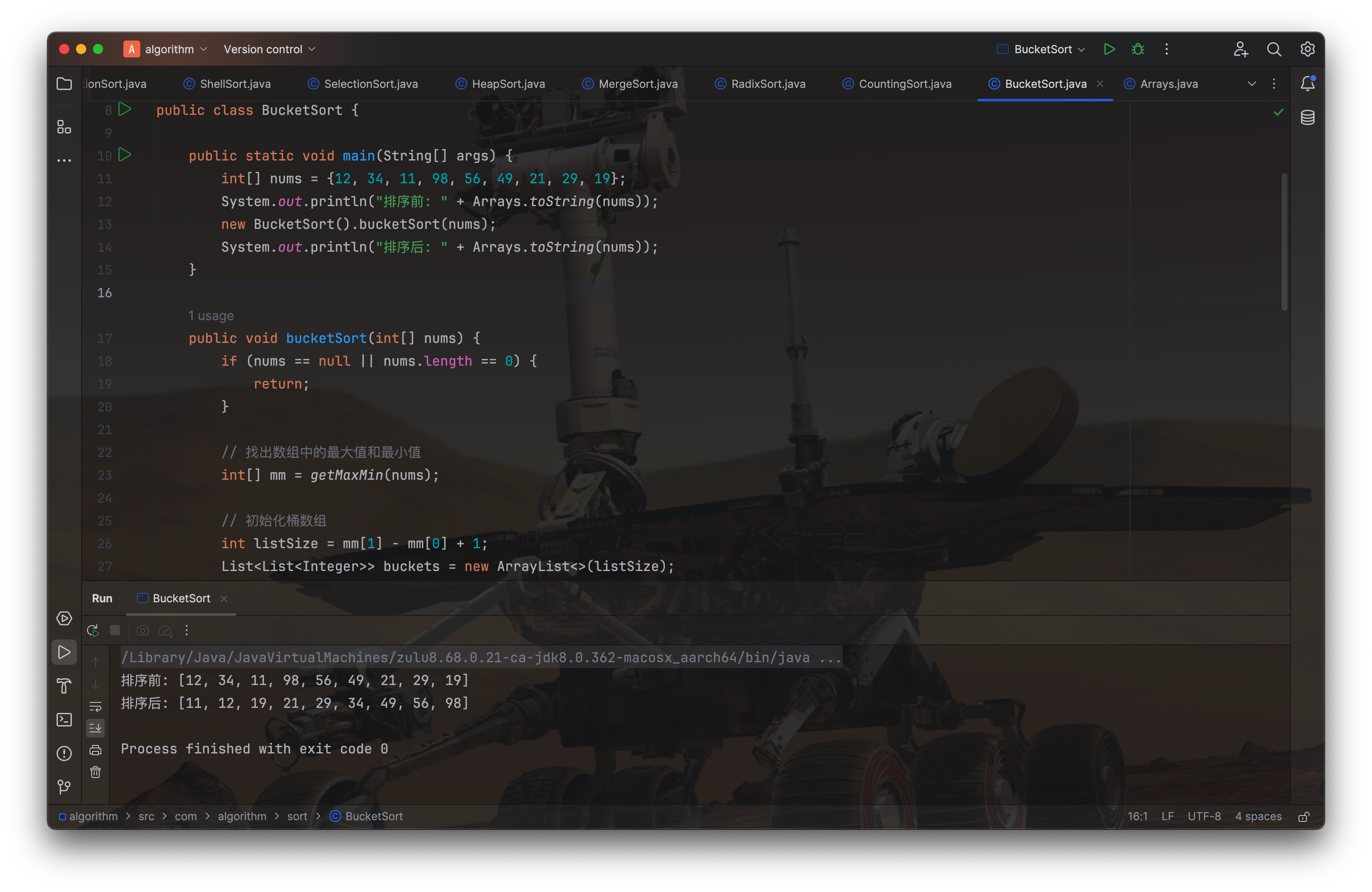
2.3 基数排序
public class RadixSort {public static void main(String[] args) {int[] nums = {12, 34, 11, 98, 56, 49, 21, 29, 19};System.out.println("排序前: " + Arrays.toString(nums));new RadixSort().radixSort(nums);System.out.println("排序后: " + Arrays.toString(nums));}public void radixSort(int[] nums) {int[] mm = getMaxMin(nums);int len = String.valueOf(mm[1]).length();@SuppressWarnings("unchecked")LinkedList<Integer>[] digits = new LinkedList[19];for (int powCount = 0; powCount < len; powCount++) {for (int num : nums) {int idx = (int) Math.abs(num / Math.pow(10, powCount) % 10);idx = num >= 0 ? 9 + idx : 9 - idx;if (digits[idx] == null) digits[idx] = new LinkedList<>();digits[idx].add(num);}for (int i = 0, j = 0; j < digits.length; j++) {while (digits[j] != null && !digits[j].isEmpty()) {nums[i++] = digits[j].removeFirst();}}}}private static int[] getMaxMin(int[] nums) {int max = nums[0], min = nums[0];for (int i = 1; i < nums.length; i++) {if (nums[i] > max) max = nums[i];if (nums[i] < min) min = nums[i];}return new int[]{min, max};}
}
